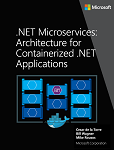Note
Access to this page requires authorization. You can try signing in or changing directories.
Access to this page requires authorization. You can try changing directories.
Tip
This content is an excerpt from the eBook, .NET Microservices Architecture for Containerized .NET Applications, available on .NET Docs or as a free downloadable PDF that can be read offline.

A microservice API is a contract between the service and its clients. You'll be able to evolve a microservice independently only if you do not break its API contract, which is why the contract is so important. If you change the contract, it will impact your client applications or your API Gateway.
The nature of the API definition depends on which protocol you're using. For instance, if you're using messaging, like AMQP, the API consists of the message types. If you're using HTTP and RESTful services, the API consists of the URLs and the request and response JSON formats.
However, even if you're thoughtful about your initial contract, a service API will need to change over time. When that happens—and especially if your API is a public API consumed by multiple client applications — you typically can't force all clients to upgrade to your new API contract. You usually need to incrementally deploy new versions of a service in a way that both old and new versions of a service contract are running simultaneously. Therefore, it's important to have a strategy for your service versioning.
When the API changes are small, like if you add attributes or parameters to your API, clients that use an older API should switch and work with the new version of the service. You might be able to provide default values for any missing attributes that are required, and the clients might be able to ignore any extra response attributes.
However, sometimes you need to make major and incompatible changes to a service API. Because you might not be able to force client applications or services to upgrade immediately to the new version, a service must support older versions of the API for some period. If you're using an HTTP-based mechanism such as REST, one approach is to embed the API version number in the URL or into an HTTP header. Then you can decide between implementing both versions of the service simultaneously within the same service instance, or deploying different instances that each handle a version of the API. A good approach for this functionality is the Mediator pattern (for example, MediatR library) to decouple the different implementation versions into independent handlers.
Finally, if you're using a REST architecture, Hypermedia is the best solution for versioning your services and allowing evolvable APIs.
Additional resources
Scott Hanselman. ASP.NET Core RESTful Web API versioning made easy
https://www.hanselman.com/blog/ASPNETCoreRESTfulWebAPIVersioningMadeEasy.aspxVersioning a RESTful web API
https://learn.microsoft.com/azure/architecture/best-practices/api-design#versioning-a-restful-web-apiRoy Fielding. Versioning, Hypermedia, and REST
https://www.infoq.com/articles/roy-fielding-on-versioning
